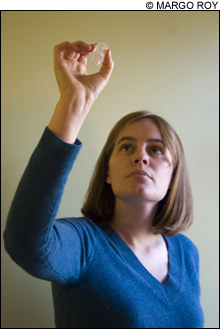Spencer and a business partner have practiced myofascial release, deep tissue, and craniosacral bodywork for more than two years. A 2007 graduate of Spa-Tech Institute in Westbrook, she finds that an increased public interest in her services has been neutralized by what is seen as a prohibitive cost, amounting to inconsistent client traffic.
Jessica Healy, a 31-year-old Kennebunk native who runs an integrative healing practice in the Old Port called the Living Tea Room, is in a similar position, balancing the new tide of interested clients with the limitations of economic hardship: "The need is always there. There might be two months were all these new people are calling me, and there might be a gap where I won't even get a phone call for a week or two."
Both Spencer and Healy agree that while business has been erratic, they can't attribute it to a lack of interest.
"I have tons of clients that have come because they've exhausted all other avenues," Healy says, "They've been to talk therapy for 10 years, they've been on meds, they (may) have a terminal illness, and they're looking for a last hope type thing."
Under the umbrella of "soul-centered healing," the breadth of Healy's practice offers a kaleidoscopic assortment of energy-based bodywork treatments including guided imagery, chakra healing, and past-life regression therapy. The biggest challenge facing her practice, she says, is working "in an unstable financial environment where most people don't have the money to pay for services, but still wanting to provide the services to make ends meet. If I were independently wealthy, I would totally do this for like, 20 bucks. No problem."
For people who are already paying big chunks of money for health-insurance plans, it's next to impossible to come up with money for alternative practices not covered by their insurance.
According to the American Massage Therapy Association, 86 percent of Americans believe that massage can be beneficial for health, wellness, and pain relief. Yet, only 19 percent received a massage in 2010, a figure down from 23 percent the previous year. Among men, those figures are almost halved, with only 10 percent reporting work done in 2010 (down from 18 percent). What accounts for the gap?
"Obviously you have to have a job making a decent amount of money," says Steven Thomas, a deep tissue and craniosacral massage therapist in Yarmouth. "That's the problem . . . it's not covered. More and more insurance companies are not covering it. Insurances are covering less and less. I used to have clients who used to have coverage and now they don't."
A Portland resident who moving his practice to Maine after getting certification in San Francisco, Thomas sees the greater Portland community as primed for a sea change. "Portland is this really burgeoning area. They're really into alternative ways of doing things — they might need more of a push to try something new, but they're open to trying it."

RAISING A CRYSTAL Polarity therapist Cailin O’Connor pauses during a treatment session. |
GAINING ACCESS
At least on one level, Thomas is exactly right. Some of the industry's most dependable clients are Portland's 1400 city employees, whose Anthem insurance plan entitles them to up to $1000 in annual benefits toward massage, chiropractic care, and acupuncture (that's $1000 per field, not total).